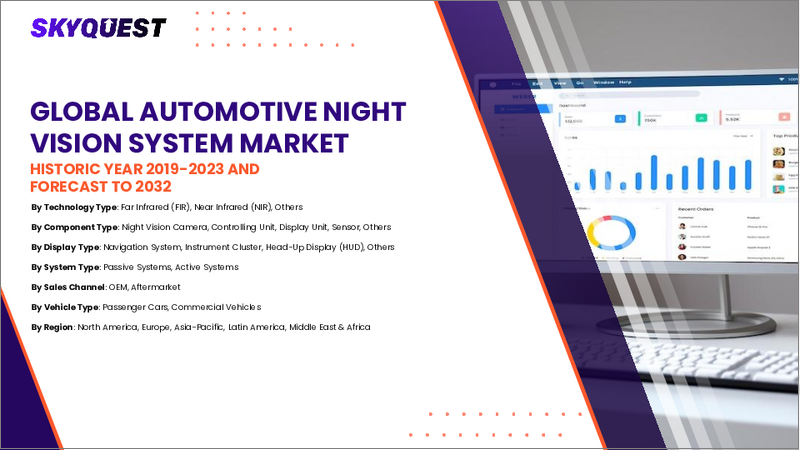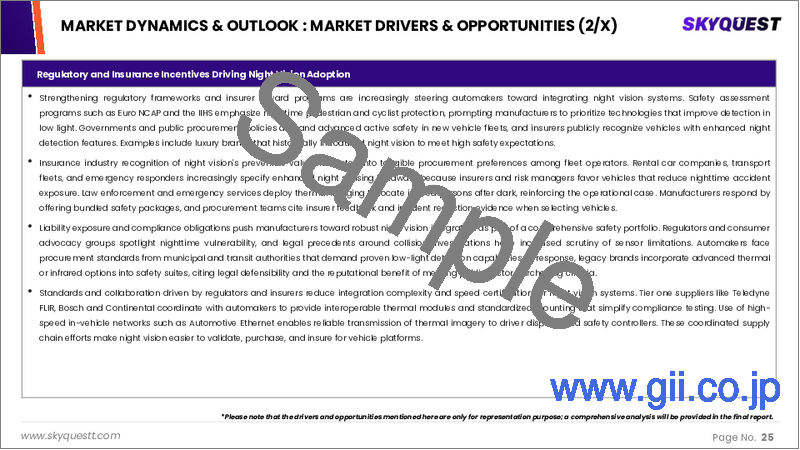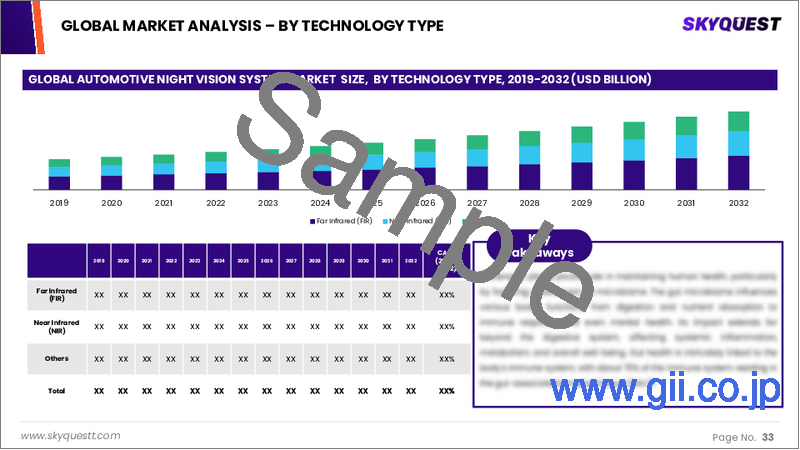|
|
市場調査レポート
商品コード
1647449
自動車用ナイトビジョンシステムの市場規模、シェア、成長分析:コンポーネント別、ディスプレイタイプ別、技術タイプ別、車両タイプ別、地域別 - 産業予測 2025年~2032年Automotive Night Vision System Market Size, Share, and Growth Analysis, By Component, By Display Type, By Technology Type, By Vehicle Type, By Region - Industry Forecast 2025-2032 |
||||||
|
|||||||
| 自動車用ナイトビジョンシステムの市場規模、シェア、成長分析:コンポーネント別、ディスプレイタイプ別、技術タイプ別、車両タイプ別、地域別 - 産業予測 2025年~2032年 |
|
出版日: 2025年01月28日
発行: SkyQuest
ページ情報: 英文 197 Pages
納期: 3~5営業日
|
全表示
- 概要
- 目次
自動車用ナイトビジョンシステム市場規模は2023年に37億米ドルで、2024年の41億6,000万米ドルから2032年には105億1,000万米ドルに成長し、予測期間(2025-2032年)のCAGRは12.3%で成長する見通しです。
ADAS(先進運転支援システム)、特に自動車用暗視システムの需要は、低照度時の交通安全が重視されるにつれて急増しています。これらのシステムは視認性を高め、ドライバーは従来のヘッドライトでは見逃してしまう歩行者や動物などの潜在的な危険を発見できるようになります。交通安全に対する意識の高まりにより、各国政府はより厳しい安全規制を実施するようになり、自動車メーカーは最先端の安全機能を取り入れるよう迫られています。高解像度カメラや熱画像センサーなどの技術革新により、これらのシステムの機能性と価格競争力が向上し、様々な車種に導入しやすくなっています。北米と欧州市場は、厳しい規制と所得水準の高さから導入率が高い市場ですが、アジア太平洋地域の新興国市場も、高級車需要の高まりに伴い、この市場の成長に大きく貢献しています。
目次
イントロダクション
- 調査の目的
- 調査範囲
- 定義
調査手法
- 情報調達
- 二次データと一次データの方法
- 市場規模予測
- 市場の前提条件と制限
エグゼクティブサマリー
- 世界市場の見通し
- 供給と需要の動向分析
- セグメント別機会分析
市場力学と見通し
- 市場概要
- 市場規模
- 市場力学
- 促進要因と機会
- 抑制要因と課題
- ポーターの分析
主な市場の考察
- 重要成功要因
- 競合の程度
- 主な投資機会
- 市場エコシステム
- 市場の魅力指数(2024年)
- PESTEL分析
- マクロ経済指標
- バリューチェーン分析
- 価格分析
- 規制情勢
- ケーススタディ
- 技術の進歩
自動車用ナイトビジョンシステム市場規模:コンポーネント別& CAGR(2025-2032)
- 市場概要
- 暗視カメラ
- 制御ユニット
- ディスプレイユニット
- センサー
自動車用ナイトビジョンシステム市場規模:ディスプレイタイプ別& CAGR(2025-2032)
- 市場概要
- ナビゲーションシステム
- 計器クラスター
- ヘッドアップディスプレイ
自動車用ナイトビジョンシステム市場規模:技術タイプ別& CAGR(2025-2032)
- 市場概要
- 遠赤外線(FIR)
- 近赤外線(NIR)
自動車用ナイトビジョンシステム市場規模:車両タイプ別& CAGR(2025-2032)
- 市場概要
- 乗用車
- 商用車
自動車用ナイトビジョンシステム市場規模:地域別& CAGR(2025-2032)
- 北米
- 米国
- カナダ
- 欧州
- ドイツ
- スペイン
- フランス
- 英国
- イタリア
- その他欧州地域
- アジア太平洋地域
- 中国
- インド
- 日本
- 韓国
- その他アジア太平洋地域
- ラテンアメリカ
- ブラジル
- その他ラテンアメリカ地域
- 中東・アフリカ
- GCC諸国
- 南アフリカ
- その他中東・アフリカ
競合情報
- 上位5社の比較
- 主要企業の市場ポジショニング(2024年)
- 主な市場企業が採用した戦略
- 市場の最近の動向
- 企業の市場シェア分析(2024年)
- 主要企業の企業プロファイル
- 会社概要
- 製品ポートフォリオ分析
- セグメント別シェア分析
- 収益の前年比比較(2022-2024)
主要企業プロファイル
- Robert Bosch GmbH(Germany)
- DENSO Corporation(Japan)
- Audi AG(Germany)
- Daimler AG(Germany)
- Autoliv Inc.(Sweden)
- Visteon Corporation(USA)
- Magna International Inc.(Canada)
- L3Harris Technologies, Inc.(USA)
- Raytheon Company(USA)
- Aisin Seiki Co., Ltd.(Japan)
- Delphi Automotive PLC(UK)
- Valeo SA(France)
- HELLA GmbH & Co. KGaA(Germany)
- FLIR Systems Inc.(USA)
- Continental AG(Germany)
- ZF Friedrichshafen AG(Germany)
- OmniVision Technologies(USA)
- Teledyne Technologies(USA)
- Panasonic Corporation(Japan)
- Gentex Corporation(USA)
結論と推奨事項
Automotive Night Vision System Market size was valued at USD 3.7 billion in 2023 and is poised to grow from USD 4.16 billion in 2024 to USD 10.51 billion by 2032, growing at a CAGR of 12.3% during the forecast period (2025-2032).
The demand for advanced driver assistance systems (ADAS), particularly automotive night vision systems, is surging as the emphasis on road safety during low-light conditions intensifies. These systems enhance visibility, enabling drivers to spot potential hazards like pedestrians and animals that conventional headlights may miss. Rising awareness about road safety has led governments to enforce stricter safety regulations, pressuring automotive manufacturers to incorporate state-of-the-art safety features. Technological advancements, including high-resolution cameras and thermal imaging sensors, have improved both the functionality and affordability of these systems, making them more accessible across various vehicle types. While North America and European markets dominate adoption due to stringent regulations and high income, emerging economies in Asia Pacific are also contributing to significant market growth as luxury vehicle demand rises.
Top-down and bottom-up approaches were used to estimate and validate the size of the Automotive Night Vision System market and to estimate the size of various other dependent submarkets. The research methodology used to estimate the market size includes the following details: The key players in the market were identified through secondary research, and their market shares in the respective regions were determined through primary and secondary research. This entire procedure includes the study of the annual and financial reports of the top market players and extensive interviews for key insights from industry leaders such as CEOs, VPs, directors, and marketing executives. All percentage shares split, and breakdowns were determined using secondary sources and verified through Primary sources. All possible parameters that affect the markets covered in this research study have been accounted for, viewed in extensive detail, verified through primary research, and analyzed to get the final quantitative and qualitative data.
Automotive Night Vision System Market Segments Analysis
Global Automotive Night Vision System Market is segmented by Component, Display Type, Technology Type, Vehicle Type and region. Based on Component, the market is segmented into Night Vision Camera, Controlling Unit, Display Unit and Sensor. Based on Display Type, the market is segmented into Navigation System, Instrument Cluster and HUD. Based on Technology Type, the market is segmented into Far Infrared (FIR) and Near Infrared (NIR). Based on Vehicle Type, the market is segmented into Passenger Vehicle and Commercial Vehicle. Based on region, the market is segmented into North America, Europe, Asia Pacific, Latin America and Middle East & Africa.
Driver of the Automotive Night Vision System Market
The surging demand for luxury and high-end vehicles, particularly in emerging markets, has significantly contributed to the growth of the automotive night vision system market. As consumer preferences shift towards premium automobiles, manufacturers in this sector are focused on exceeding the expectations of their sophisticated clientele. To address this rising demand and improve the safety features of their offerings, luxury car producers are increasingly incorporating advanced technologies like night vision systems. By integrating these state-of-the-art safety enhancements, manufacturers aim to provide superior visibility and elevate the sense of security for drivers during night-time journeys, establishing a competitive edge in the market.
Restraints in the Automotive Night Vision System Market
The automotive night vision system market faces significant restraints due to the technical challenges associated with integrating these systems into vehicles. This is particularly true when retrofitting existing models or incorporating them during production. Such integration hurdles introduce complexities and additional expenses that hinder the widespread adoption of night vision technology, thereby limiting market growth. The intricate task of ensuring seamless integration involves careful design consideration, wiring, compatibility, and overall system functionality. Addressing these challenges is essential, as simplifying the incorporation of night vision systems will be vital for the market's expansion and long-term success.
Market Trends of the Automotive Night Vision System Market
The automotive night vision system market is experiencing a dynamic upward trend, bolstered by the advent of high-end systems and advanced ignition technology. This growth is fueled by the integration of sophisticated night vision capabilities into vehicles, providing not only enhanced safety but also improving theft deterrence. With the rise of connected vehicles and autonomous driving features, the demand for these systems is set to escalate. Additionally, the push towards vehicle electrification is creating a ripe environment for innovation, presenting significant opportunities for manufacturers. These developments are redefining automotive safety standards and expanding the market for night vision technologies, ultimately revolutionizing the driving experience.
Table of Contents
Introduction
- Objectives of the Study
- Scope of the Report
- Definitions
Research Methodology
- Information Procurement
- Secondary & Primary Data Methods
- Market Size Estimation
- Market Assumptions & Limitations
Executive Summary
- Global Market Outlook
- Supply & Demand Trend Analysis
- Segmental Opportunity Analysis
Market Dynamics & Outlook
- Market Overview
- Market Size
- Market Dynamics
- Drivers & Opportunities
- Restraints & Challenges
- Porters Analysis
- Competitive rivalry
- Threat of substitute
- Bargaining power of buyers
- Threat of new entrants
- Bargaining power of suppliers
Key Market Insights
- Key Success Factors
- Degree of Competition
- Top Investment Pockets
- Market Ecosystem
- Market Attractiveness Index, 2024
- PESTEL Analysis
- Macro-Economic Indicators
- Value Chain Analysis
- Pricing Analysis
- Regulatory Landscape
- Case Studies
- Technological Advancement
Global Automotive Night Vision System Market Size by Component & CAGR (2025-2032)
- Market Overview
- Night Vision Camera
- Controlling Unit
- Display Unit
- Sensor
Global Automotive Night Vision System Market Size by Display Type & CAGR (2025-2032)
- Market Overview
- Navigation System
- Instrument Cluster
- HUD
Global Automotive Night Vision System Market Size by Technology Type & CAGR (2025-2032)
- Market Overview
- Far Infrared (FIR)
- Near Infrared (NIR)
Global Automotive Night Vision System Market Size by Vehicle Type & CAGR (2025-2032)
- Market Overview
- Passenger Vehicle
- Commercial Vehicle
Global Automotive Night Vision System Market Size & CAGR (2025-2032)
- North America (Component, Display Type, Technology Type, Vehicle Type)
- US
- Canada
- Europe (Component, Display Type, Technology Type, Vehicle Type)
- Germany
- Spain
- France
- UK
- Italy
- Rest of Europe
- Asia Pacific (Component, Display Type, Technology Type, Vehicle Type)
- China
- India
- Japan
- South Korea
- Rest of Asia-Pacific
- Latin America (Component, Display Type, Technology Type, Vehicle Type)
- Brazil
- Rest of Latin America
- Middle East & Africa (Component, Display Type, Technology Type, Vehicle Type)
- GCC Countries
- South Africa
- Rest of Middle East & Africa
Competitive Intelligence
- Top 5 Player Comparison
- Market Positioning of Key Players, 2024
- Strategies Adopted by Key Market Players
- Recent Developments in the Market
- Company Market Share Analysis, 2024
- Company Profiles of All Key Players
- Company Details
- Product Portfolio Analysis
- Company's Segmental Share Analysis
- Revenue Y-O-Y Comparison (2022-2024)
Key Company Profiles
- Robert Bosch GmbH (Germany)
- Company Overview
- Business Segment Overview
- Financial Updates
- Key Developments
- DENSO Corporation (Japan)
- Company Overview
- Business Segment Overview
- Financial Updates
- Key Developments
- Audi AG (Germany)
- Company Overview
- Business Segment Overview
- Financial Updates
- Key Developments
- Daimler AG (Germany)
- Company Overview
- Business Segment Overview
- Financial Updates
- Key Developments
- Autoliv Inc. (Sweden)
- Company Overview
- Business Segment Overview
- Financial Updates
- Key Developments
- Visteon Corporation (USA)
- Company Overview
- Business Segment Overview
- Financial Updates
- Key Developments
- Magna International Inc. (Canada)
- Company Overview
- Business Segment Overview
- Financial Updates
- Key Developments
- L3Harris Technologies, Inc. (USA)
- Company Overview
- Business Segment Overview
- Financial Updates
- Key Developments
- Raytheon Company (USA)
- Company Overview
- Business Segment Overview
- Financial Updates
- Key Developments
- Aisin Seiki Co., Ltd. (Japan)
- Company Overview
- Business Segment Overview
- Financial Updates
- Key Developments
- Delphi Automotive PLC (UK)
- Company Overview
- Business Segment Overview
- Financial Updates
- Key Developments
- Valeo SA (France)
- Company Overview
- Business Segment Overview
- Financial Updates
- Key Developments
- HELLA GmbH & Co. KGaA (Germany)
- Company Overview
- Business Segment Overview
- Financial Updates
- Key Developments
- FLIR Systems Inc. (USA)
- Company Overview
- Business Segment Overview
- Financial Updates
- Key Developments
- Continental AG (Germany)
- Company Overview
- Business Segment Overview
- Financial Updates
- Key Developments
- ZF Friedrichshafen AG (Germany)
- Company Overview
- Business Segment Overview
- Financial Updates
- Key Developments
- OmniVision Technologies (USA)
- Company Overview
- Business Segment Overview
- Financial Updates
- Key Developments
- Teledyne Technologies (USA)
- Company Overview
- Business Segment Overview
- Financial Updates
- Key Developments
- Panasonic Corporation (Japan)
- Company Overview
- Business Segment Overview
- Financial Updates
- Key Developments
- Gentex Corporation (USA)
- Company Overview
- Business Segment Overview
- Financial Updates
- Key Developments





